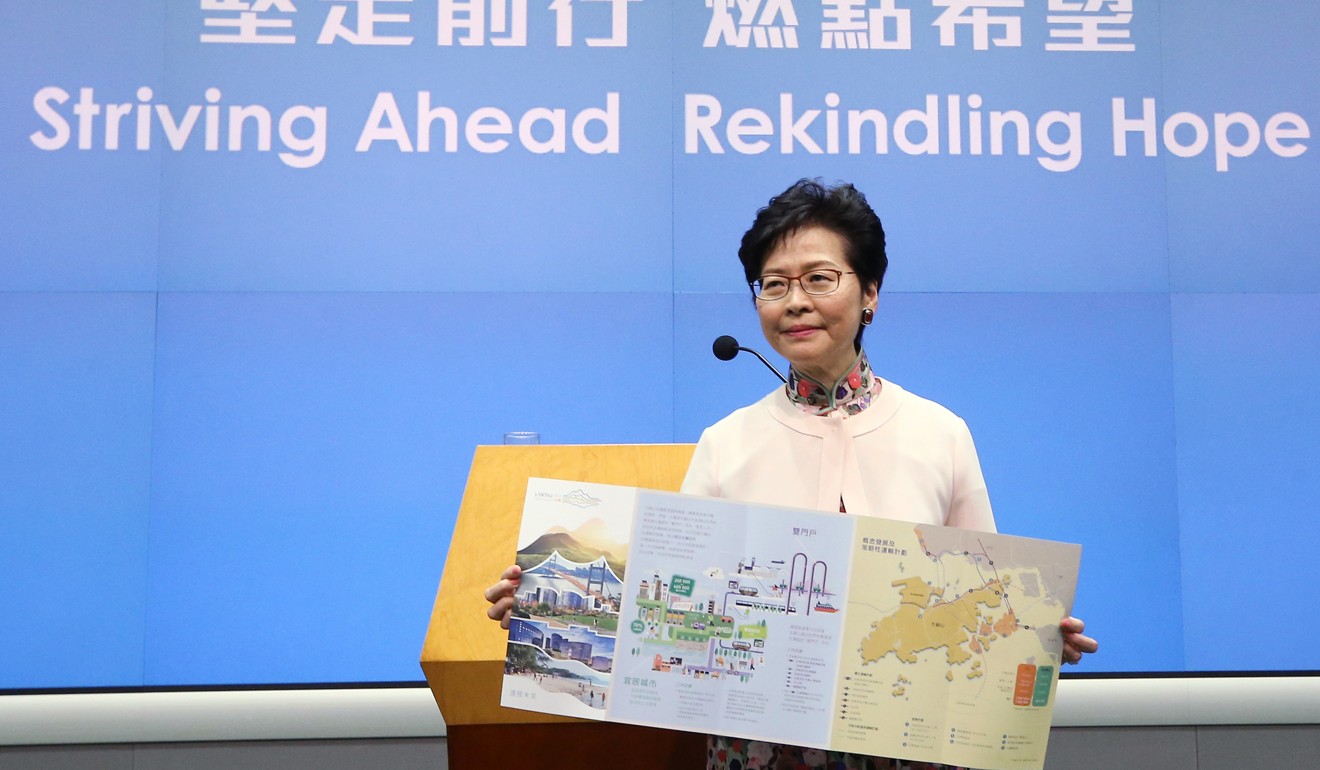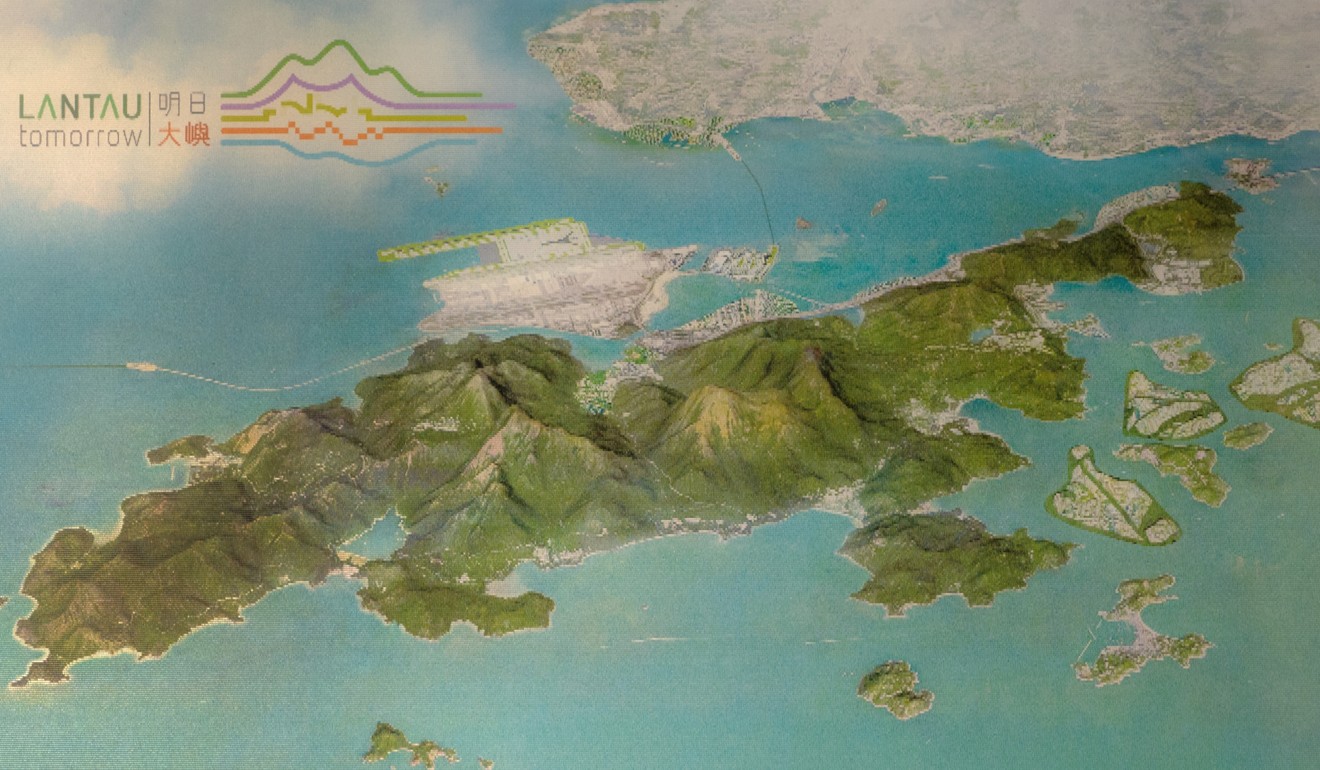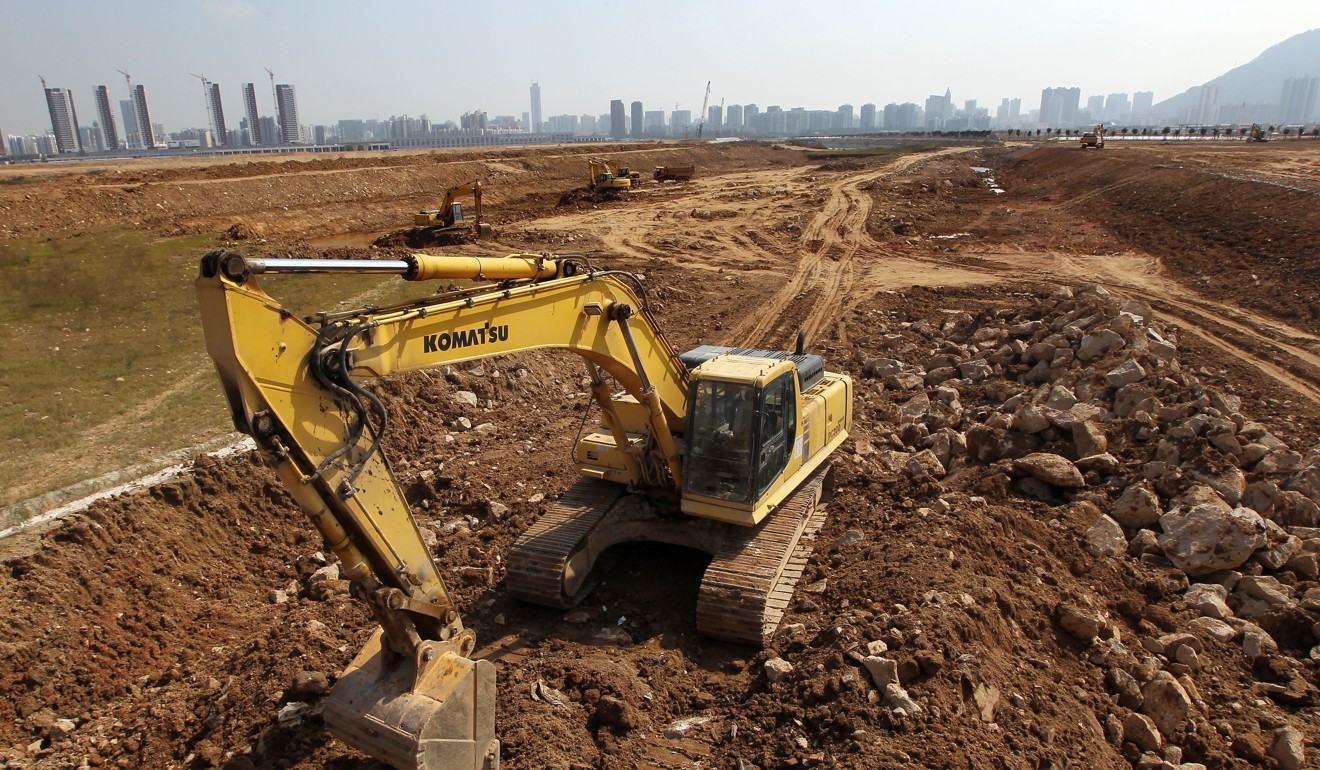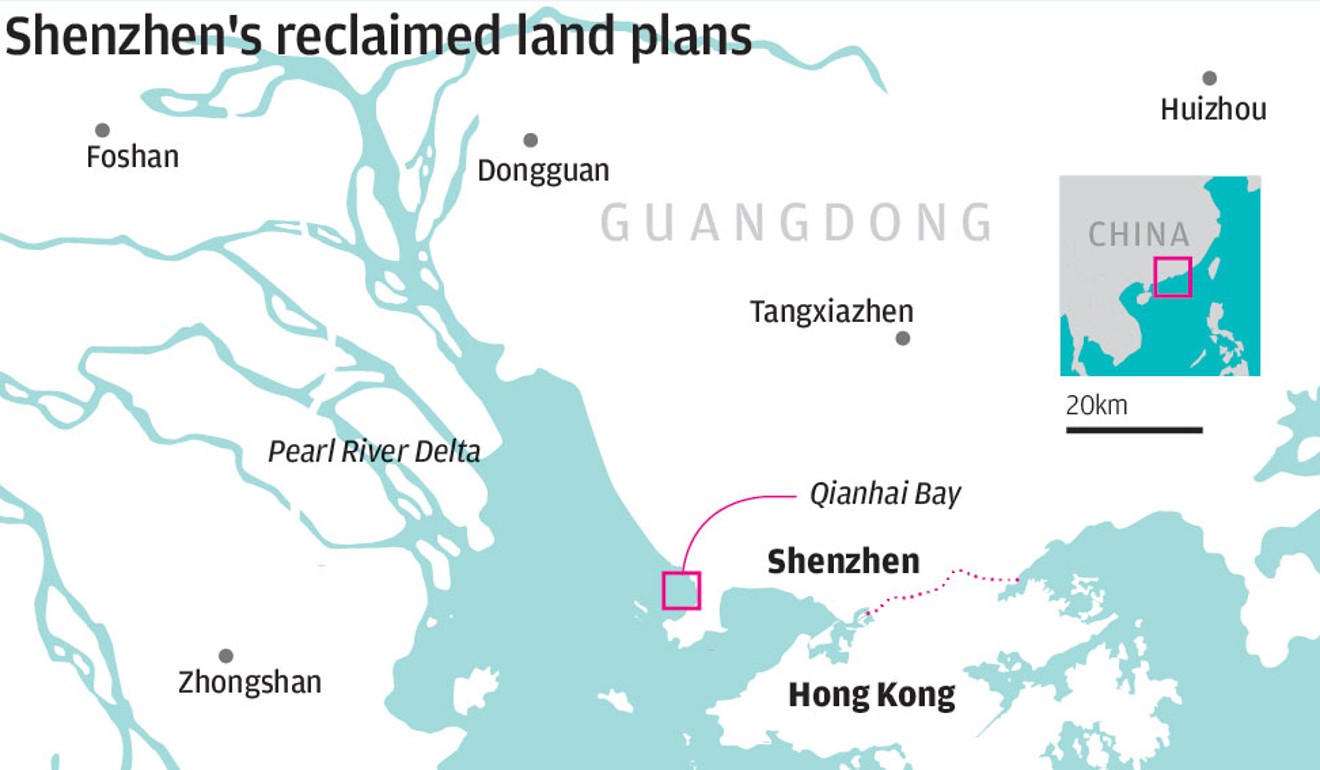
Hong Kong, Shenzhen multibillion-dollar land reclamation plans may be on collision course
- The vast resources needed for Hong Kong’s Lantau Tomorrow Vision project could clash with Shenzhen’s plan to build a maritime hub also on reclaimed land
- Limited resources could drive costs of both projects higher, particularly the Lantau scheme championed by Hong Kong leader Carrie Lam Cheng Yuet-ngor
Industry experts and academics have warned attempting to undertake two major land reclamation's in Hong Kong and Shenzhen at the same time could strain the resources of the Greater Bay Area, ultimately increasing the costs of the already multibillion-dollar projects.
Hong Kong’s controversial Lantau Tomorrow Vision development project, in particular, already faces daunting cost estimates, which could be further increased if it does not have access to abundant supplies of relatively cheap landfill material.
Competition with Shenzhen for those supplies could create a major cost overrun for the project, which was disclosed by Hong Kong leader Carrie Lam Cheng Yuet-ngor in her annual policy speech in October.
The Lantau scheme, covering reclamation of 1,700 hectares (4,200 acres) from the sea, involves the construction of artificial islands off Lantau Island in western Hong Kong.

The official blueprint for the GBA will only be revealed in early 2019, and will outline Beijing’s grand plan to integrate Hong Kong, Macau and nine southern mainland cities – Guangzhou, Shenzhen, Zhuhai, Foshan, Zhongshan, Dongguan, Huizhou, Jiangmen and Zhaoqing – into one huge megacity.
It is expected to become a leading hub for innovation and economic growth, but under the GBA integration scheme, local officials must consider the needs of and impact on the entire region when undertaking major construction projects, according to Zheng Tianxiang, professor at the Center for Studies of Hong Kong, Macao and the Pearl River Delta at Sun Yat-sen University in Guangzhou.
“If two major land reclamation projects are underway at the same time in Shenzhen and Hong Kong, it might cause a supply shortage of reclamation materials in the GBA, increasing the costs as well as putting pressure on the area’s marine environment,” he said.
If all relevant strategic goals in the region are taken into account in a balanced manner, it will help Hong Kong make the best use of the resources in the GBA and lower the budget for the Lantau Tomorrow Vision project, Zheng added.
“Lantau Tomorrow will not just be a new sub-centre of Hong Kong, but also an important link with western Guangdong and so it will play a leading role in the GBA. The provincial and central governments will support it,” he said.
The Pearl River Delta has sufficient resources of river, sand and soil, with over 10 million cubic metres of sand created naturally each year, Zheng said, but it must be used economically to keep costs from skyrocketing.

Edwin Chung Kwok-fai, vice-president of the Hong Kong Institution of Engineers, has been involved in reclamation projects for more than 30 years, and echoed Zheng’s sentiments.
“There are no detailed plans yet for the sourcing of reclamation materials [for Lantau Tomorrow Vision]. But it will take over 10 million tonnes of filling material, and so it would be good if Hong Kong communicates with Guangdong or the central government to take in consideration the overall supply of materials for the area’s future reclamation projects.” he said.
The preliminary budget for the Lantau Tomorrow Vision project is estimated to be in the region of HK$500 billion (US$66.84 billion), a government source told the South China Morning Post in November, which works out at around HK$29,412 (US$3,755) per square metre.
Shenzhen has already reclaimed at least 6,900 hectares (17,050 acres) of land since it was established in 2013, and according to the city’s infrastructure development blueprint, Shenzhen plans to reclaim an additional 5,000 hectares from the sea between 2016 to 2025.
It estimates this will cost 27.3 billion yuan (US$3.97 billion), or 546 yuan (US$79.38) per square metre, highlighting the varying costs between the cities in the GBA.
Shenzhen’s location means it is has access to easier and cheaper solutions for reclamation compared to Hong Kong, according to Hong Kong Institution of Engineers vice-president Chung.
It also has an abundant existing supply of cheap filling materials, including huge sources of construction waste and soil deposits generated by construction activities including the Shenzhen Metro.
“When it comes to Lantau Tomorrow, there is more than six metres (20 feet) of deep water to fill and another six or seven metres to accumulate [above sea level],” Chung said, who also stressed Hong Kong must make careful use of all the resources in the Pearl River Delta to deliver the project on time and on budget.
Shenzhen is looking at its own reclamation project to spur growth and help reduce housing costs, although there are a number of hurdles to be overcome before the first load of landfill is unloaded.
Local environmental groups and government advisers are questioning whether the city should be allowed to aggressively reclaim more land from the sea.
Supporters, that include local think tanks and political advisers, argue that further land reclamation is essential to ensure the city’s future competitiveness, which they say is also essential to China’s national strategy for innovation-driven development.
Opponents argue the plan will lead to an overcapacity in regional shipping infrastructure and further damage the region’s delicate environment.

The need to stimulate growth in the face of the trade war-induced economic slowdown may well be the trump card that the Shenzhen government plays to move forward with its reclamation plans.
Whether Shenzhen’s vision comes to pass remains to be seen as among numerous other obstacles to the plan include tough new regulation on land reclamation along the country’s coastline, which were approved by Beijing last year.
However, the central government has already shown that it is willing to set aside environmental goals to help stabilise growth and preserve jobs.
In any case, the municipal government of Shenzhen is moving ahead, having approved a plan to make the city a global marine centre by 2035.
Shenzhen’s imagination has been stimulated by Hong Kong’s ambitious Lantau Tomorrow Vision project, which aims to house one million residents.
The Shenzhen plan also follows on from Beijing’s strategy to build a 21st Century Maritime Silk Road by enhancing bilateral and multilateral maritime cooperation with other countries and fostering world-class marine industrial clusters in the GBA, according to a blueprint released by China’s National Development and Reform Commission in 2017.
The strategy by China’s planning agency also envisions building Shanghai and Shenzhen into global marine centres.

Shenzhen’s main argument for reclamation is that building a maritime hub will ensure continued strong economic growth for the city and the region.
By 2020, it estimates its current maritime economy could generate annual income of 300 billion yuan (US$43.61 billion), up from 166 billion in 2017 and 100 billion in 2012.
Funds totalling 50 billion yuan (US$7.29 billion) will be raised to support the marine industry and foster the development of a world-class marine industrial cluster worth of hundreds of billions of yuan, according to the city government’s plan, but it did not specify how much the state will spend.
The most ambitious version of the plan, championed by Chen Keshi, a member of the Shenzhen Chinese People’s Political Consultative Conference, would reclaim around 3,000 hectares (7,413 acres) of land on the western side of Qianhai Bay, which is around half the size of Manhattan Island in New York.
“Shenzhen’s future competitiveness is essential for China’s national strategies, including the Greater Bay Area initiative as well as innovation-Driven Development,” Chen said, adding that reclamation is an effective and necessary way to solve a major constraint on Shenzhen’s development.
In addition to boosting growth, the reclamation project could also help curb soaring property costs by increasing the supply of land for housing and industry, according to supporters.

Already high and rising property prices threaten to hurt Shenzhen’s ability to lure talent, new businesses and investment capital, Chen added, arguing that Hong Kong has suffered from lack of innovation because of its high rental prices.
Guo Wanda, vice-president of the China Development Institute, a think tank linked to the Shenzhen government that backs the land reclamation proposal, warned that a number of technology and manufacturing companies have already moved production out of the city because of surging costs.
The city’s interest in reclaiming land has been supported by growing public concern that Shenzhen might lose its competitive edge because of the increase in property prices over the past a few years.
However, given the increased emphasis on taking steps to stabilise growth amid the trade war with the United States, environmental rules could be set aside and new reclamation projects launched in Guangdong to increase the competitiveness of the GBA and to attract large foreign investment projects, said economist Lin Jiang, from Lingnan College at Sun Yat-sen University.
Foreign investment projects are particularly welcome as they can demonstrate China’s openness and help Beijing to compete with the US in the global public relations war over trade issues.
“Shenzhen is eager to find a new economic growth engine so that it can achieve its aggressive [gross domestic product] targets while offsetting the slide in exports and manufacturing caused by the trade war between China and the US,” Lin said.
“The so-called global marine centre initiative, backed by Shenzhen’s hi-tech and services industries, sounds like a good option.”

Both Shenzhen Chinese People’s Political Consultative Conference deputy Chen and China Development Institute vice-president Guo believe Beijing’s strategy to make Shenzhen into a global maritime hub will also help put land reclamation on the agenda in future.
“Hong Kong’s Lantau Tomorrow Vision project will also help ease the opposition pressure in Shenzhen.” Chen said.
Local environmental groups, though, argue that new reclamation projects in Shenzhen are prohibited under China’s new coastline preservation rules.
In January, Beijing introduced its toughest regulation yet on land reclamation along the country’s coastline, vowing to demolish illegally reclaimed land and stop approving general reclamation projects.
The central government said it would stop approving property development plans based on land reclamation and will prohibit all reclamation activities unless they pertain to important national infrastructure projects, public welfare or national defence.
According to the State Oceanic Administration, reclamation projects that have been approved but not started and do not comply with the current policy will be stopped, while Beijing will also stop giving annual land reclamation quotas to provincial governments.
“The new rules encourage us to fight against reclamation in Guangdong. It’s very encouraging to see land reclamation projects along the Greater Bay coastline, like Shenzhen’s Xiaochandao island port and warehouse reclamation project, and Dongguan’s planned Binhaiwan new district, will be downsized or shelved.” said Aster Lee, a spokesman for the Cross-border Environment Concern Association, a non-governmental group that seeks to protect the local environment of the Pearl River Delta.
Currently, only one 703 hectare (1,737 acre) reclamation project is underway in Shenzhen, intended for the Shenzhen Marine Emerging Industry Base.
“We believe that no further reclamation projects will be launched in future, besides Shenzhen Airport’s third runway.” Lee added.

